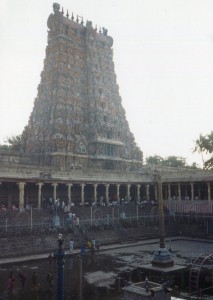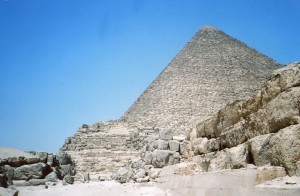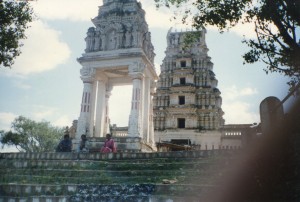Some of my posts in the last month have been building towards the pyramids at Giza. But before we get there, let’s hang a wide right from the Nile.
The Meenakshi Temple in Madurai (above) sports several towers (gopuras), and its highest rises to 171 feet.
But Madurai’s Meenakshi Temple seems the oppsite of Great Pyramid’s simple geometry. Both monuments emerged in different cultural landscapes.
The Meenakshi Temple, and most other Indian monuments, don’t embody a single abstract form. Instead its forms proliferate so much that they seem overwhelming. Profusions of patterns are common in Indian thought and art.
Temples’ gopuras soar, not as one straight line, but in several levels. Earlier posts have shown that Indians have interpreted these levels in many ways. They can be:
Different stages of spiritual evolution,
The levels of Mount Meru, and the heavens above it,
Or different eras in cosmic history. Concepts of time became as overwhelmingly vast in India as her temples.
Ancient Indians and the ancient Greek poet Hesiod believed in a succession of ages. Each had a lower level of morality and quality of life than the former. Both cultures saw their own era as the last and worst.
But Indians stretched this scheme to incredibly large domains. They called these 4 ages yugas:
1. Krita Yuga (first age): 1,728,000 years
2. Dvapara Yuga: 1,296,000 years
3. Treta Yuga: 864,000 years
4. Kali Yuga (ours): 432,000 years
The whole cycle is called a mahayuga (great yuga).
By 500 CE, the idea emerged that 1,000 mahayugas comprise a single day for Brahman, the Hindu deity who created the universe. This temporal period was called a kalpa.
But these cycles were stretched again, into a series of creations and endings, until the whole shebang is dissolved in mahapralaya (the great dissolution). Then the whole process begins again.
Indian culture often expands things–concepts of space, time and form grow into vast proliferations that are the opposites of the static geometries that Westerners have often loved. We have seen them as perfect and sacred. But Indians have often stretched them into profusions of forms, which can effect you in 2 ways:
1. You can feel overwhelmed by nature’s power and the universe’s abundance. This sense reflects India’s larger-than-life land.
2. You can feel that all forms are impermanent, and appreiate a cosmic unity that’s deeper than divisions. Instead of basking in the Pharaoh’s glory, you can realize that the glory of the universe is within you.




Comments on this entry are closed.